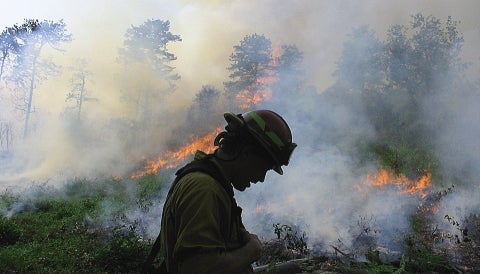Note: Yale School of the Environment (YSE) was formerly known as the Yale School of Forestry & Environmental Studies (F&ES). News articles and events posted prior to July 1, 2020 refer to the School's name at that time.
 A prescribed burn at the Albany Pine Brush Preserve in New York.
A prescribed burn at the Albany Pine Brush Preserve in New York.
If anyone should forget the important ecological role of fire in western forests, news footage of glowing wildfires and billowing smoke broadcast every year will provide a stark reminder.
By contrast, large runaway fires are hardly common in the northeastern U.S. Yet fire has played a critical part in the evolution of northern forests, too, says Mary Tyrrell, executive director of the Global Institute of Sustainable Forestry at F&ES.
In a conference this week at F&ES, leading scientists and land managers will come together to discuss the importance of fire in the ecology of northern ecosystems and the historic use of fire as a management tool from Appalachia to Canada.
The three-day event — “Fire Ecology of the Northeast: Restoring Native & Cultural Ecosystems” — will be hosted by the Yale School of Forestry & Environmental Studies and the Florida-based Tall Timbers Research Station & Land Conservancy.
By contrast, large runaway fires are hardly common in the northeastern U.S. Yet fire has played a critical part in the evolution of northern forests, too, says Mary Tyrrell, executive director of the Global Institute of Sustainable Forestry at F&ES.
In a conference this week at F&ES, leading scientists and land managers will come together to discuss the importance of fire in the ecology of northern ecosystems and the historic use of fire as a management tool from Appalachia to Canada.
The three-day event — “Fire Ecology of the Northeast: Restoring Native & Cultural Ecosystems” — will be hosted by the Yale School of Forestry & Environmental Studies and the Florida-based Tall Timbers Research Station & Land Conservancy.
Nowadays, because so many people live in the northeast, wildfires aren't allowed to burn naturally.
“Fire certainly has always been part of the ecology here, from natural fires to Native Americans’ use of fire to manage their hunting and foraging grounds,” Tyrrell said. “Regeneration of some ecosystems depends on fire, particularly pine barrens and some upland hardwoods. But nowadays, because so many people live in the northeast, wildfires aren’t allowed to burn naturally.”
While fire as a management tool has been used to a certain degree across the Northeast for centuries, some communities have become averse to the use of fire in the face of potential risks to property and a concern about the contribution to air pollution, Tyrrell says.
During the conference, which begins Thursday, land managers from across the region will share their experiences using fire to manage and restore ecosystems, from the ridgetop pine communities of West Virginia to the pine barrens of Martha’s Vineyard.
Ultimately, the host organizations will publish a summary of the conference in a Yale Forest Forum Review and many of the scientific papers will be published in a special issue of the Journal of Sustainable Forestry.
On Friday, a coalition of conservation leaders will describe efforts to create a North Atlantic Fire Science Consortium to promote increased collaboration and awareness of fire ecology strategies. The consortium would become part of an existing national network of 14 regional consortia formed by the Joint Fire Science Program, a government coalition that funds research on wildland fires and shares results with policymakers, fire managers and practitioners.
“The hope is that they can encourage policies that are more responsive to the types of fire management strategies these conservation groups want to pursue,” Tyrrell said.
While fire as a management tool has been used to a certain degree across the Northeast for centuries, some communities have become averse to the use of fire in the face of potential risks to property and a concern about the contribution to air pollution, Tyrrell says.
During the conference, which begins Thursday, land managers from across the region will share their experiences using fire to manage and restore ecosystems, from the ridgetop pine communities of West Virginia to the pine barrens of Martha’s Vineyard.
Ultimately, the host organizations will publish a summary of the conference in a Yale Forest Forum Review and many of the scientific papers will be published in a special issue of the Journal of Sustainable Forestry.
On Friday, a coalition of conservation leaders will describe efforts to create a North Atlantic Fire Science Consortium to promote increased collaboration and awareness of fire ecology strategies. The consortium would become part of an existing national network of 14 regional consortia formed by the Joint Fire Science Program, a government coalition that funds research on wildland fires and shares results with policymakers, fire managers and practitioners.
“The hope is that they can encourage policies that are more responsive to the types of fire management strategies these conservation groups want to pursue,” Tyrrell said.
– Kevin Dennehy kevin.dennehy@yale.edu 203 436-4842
Published
February 17, 2014